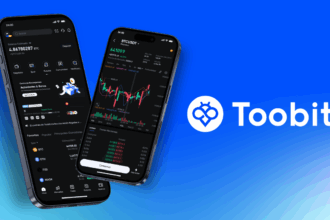The growing adoption of cryptocurrencies and advancements in technologies has increased the importance of crypto exchanges globally.
Binance and Bybit are among the top crypto exchanges in current time. These exchanges are the primary infrastructure of trading crypto assets like Bitcoin, Ethereum, Solana, Cardano and others. Beyond trading, they are emerging as efficient financial ecosystems. However, when a user needs to pick the best one, they will always go for comparison.
In this article, we will compare Binance and Bybit based on various factors like features, trading fees, customer support and security measures. We will also understand which is the best crypto exchange for 2025 and how.
What is Binance?
Binance is the world’s top crypto exchange that was founded by Changpeng Zhao in 2017 and it is headquartered in Cayman Islands.
Binance has more than 266 million registered users and offers various trading features which include spot trading, futures trading, margin trading, NFT marketplace and others.
Binance is popular due to its high level of security and liquidity and that makes it the best exchange for intraday trading.
What is Bybit?
Bybit is the second largest crypto exchange after Binance which was founded by Ben Zhou in March 2018 and headquartered in Dubai.
Bybit has more than 60 million users worldwide. It was initially developed as a derivatives trading platform but quickly expanded its trading services, including spot trading, leverage trading, margin trading and others.
Bybit is a widespread crypto exchange due to its user-friendly interface and advanced trading features that makes it significant for beginners.
Binance vs Bybit: Which is Better?
Here’s a detailed comparison between Binance and Bybit exchanges based on various factors such as features, trading fees, user interface, supported cryptocurrencies, level of security, and customer support.
Below is the detailed information of both the exchanges, according to Coinmarketcap data on April 18.
| Component | Binance | Bybit |
|---|---|---|
| Foundation Year | July, 2017 | March, 2018 |
| Ranking | Biggest Crypto Exchange | Second Biggest Crypto Exchange |
| 24-Hour Trading Volume | $10.05 Billion | $1.81 Billion |
| Average Liquidity | 903 | 676 |
| Average Weekly Visits | 10.88 Million | 3.54 Million |
| Cryptocurrencies Listed | 476 | 717 |
| Markets | 1800+ | 1200+ |
| Number of Fiat-Supported | 11 Currencies (EUR, GBP, BRL, AUD, UAH, RUB, TRY, ZAR, PLN, NGN, RON) | 6 Currencies (USD, EUR, GBP, AUD, CAD, AED) |
| Bitcoin Reserve | 248,597.54 (34.14%) | 44,194.37 (42.50%) |
Trading Features
Binance and Bybit are different in terms of offering trading features.
Leverage Trading
Binance provides its users with leverage up to 125x on Bitcoin and Ethereum and gives advance options across USDT, USDC, and inverse perpetual. It also supports cross-margin and isolated margin which help traders to control risk.
Bybit, on the other hand, offers its users leverage up to 100x on major coins like Bitcoin and Ethereum and up to 75x on Altcoins. It supports all three types of perpetual contracts and what type of margin modes make it one of the best crypto exchanges.
Advanced Order Types
Binance provides a range of advanced orders that incorporate TWAP (Time-Weighted Average Price), conditional order, trailing stop and others. These tools help investors to deal with the volatile crypto market.
Bybit offers advanced orders including unique options like Iceberg and Chase limit. Its conditional order and scaled order are designed in a way to assist crypto traders in different market conditions.
Copy Trading
Bybit assists its new traders with the copy trading feature which mirrors the trading technique of crypto whales and expert traders. This help new investors with limited knowledge to auto-copy trades of expert traders to have a profitable crypto experience.
Binance has recently introduced a copy trading feature which is not yet popular. It depends more on third-party integration for automation strategies and focuses more on trading bots rather than copy trading.
Staking and Earn Services
Binance provides its users with various staking options that support over 100 staking assets. The locked staking options help traders to earn interest on their crypto assets. It also provides ‘Simple Earn’ feature.
Bybit also offers various staking options but it is limited as compared to Binance. Its ‘Bybit Earn’ program provides users with flexible savings, DeFi staking, and dual investment to earn on their crypto assets.
Trading Fees
Binance and Bybit are different in terms of offering trading fees.
Spot Trading Fees
Binance charges its regular users with flat 0.10% spot trading fees for both maker and taker. The users can get discount of up to 25% on trading fees by using BNB tokens to pay. Furthermore, it has 9 VIP levels and users with high VIP status can enjoy significantly reduced trading fees, which go down up to 0.024%.
Bybit also charges similar spot trading fees from its users i.e. 0.10% for both makers and takers. It also has 5 VIP levels where the users with high VIP levels can get a big discount on trading fees.
Futures Trading Fees
Binance futures trading fee is less as compared to its spot trading fees which start at 0.02% (maker) and 0.05% (taker). It also has VIP levels and users with high VIP status get more discount on futures trading fees.
Bybit also matches the futures trading fees of Binance with slight variations. The base rates of Bybit’s futures trading are 0.02% for makers and 0.055% for takers. It also has VIP status and those with higher status pay lower fees.
Withdrawal Fees
Withdrawal fees of both Binance and Bybit exchanges depend on the cryptocurrency being withdrawn. Binance has lower withdrawal fees as compared to the Bybit exchange. For example, Binance’s withdrawal fee for Bitcoin is 0.0001 BTC while that of Bybit is 0.0005 BTC which is very high as compared to Binance.
Security Measures
Binance is regarded as the safest cryptocurrency exchange as it has implemented strong security protocols like 2FA, withdrawal whitelists, anti-phishing codes and may others. It has a $1 billion SAFU fund which adds extra security if there is any security breach.
Bybit also mirrors Binance on security protocols but is not as strong as Binance. Recently, it has faced the biggest hack in the crypto industry where hackers stole $1.5 billion worth of Ethereum.
Regulatory Compliance
Binance is a global crypto exchange that holds multiple licences in various countries including France, Spain, Bahrain, and Australia which makes it one of the most regulated crypto exchanges in the world. Its broad regulatory compliance increases its credibility and ensures that users can trade confidently across different jurisdictions.
Bybit is a crypto exchange that operates with limited regulatory compliances. It got license in Cyprus and a provisional license in Dubai but it does not have broader jurisdictional approvals. This limited reach makes it less accessible as compared to Binance.
User Experience
Binance provides its users with a range of features that incorporate the NFT marketplace, staking mechanism and advanced trading tools. While Binance performs various functions. Its dense layout and product variety can be confusing for beginners who are using the platform for the first time.
Bybit, on the other hand, provides a more user-friendly and easy interface which is preferred by crypto traders who want speed and simplicity. It also offers fast API response time and smooth navigation, helpful for high-frequency traders.
Conclusion
Binance and Bybit both are the top performers in the crypto landscape. Both crypto exchanges offer different features and functions to their users.
To find out which crypto exchange is the best pick depends on the demand and purpose of the user. It also mainly depends on their fees and security protocols. For instance, if a trader wants high-volume crypto trading without price slippage, Binance is the best choice while if a trader is specialized in derivatives then Bybit is the best choice.
Also Read: Bybit will offer daily industry report to its VIP users










